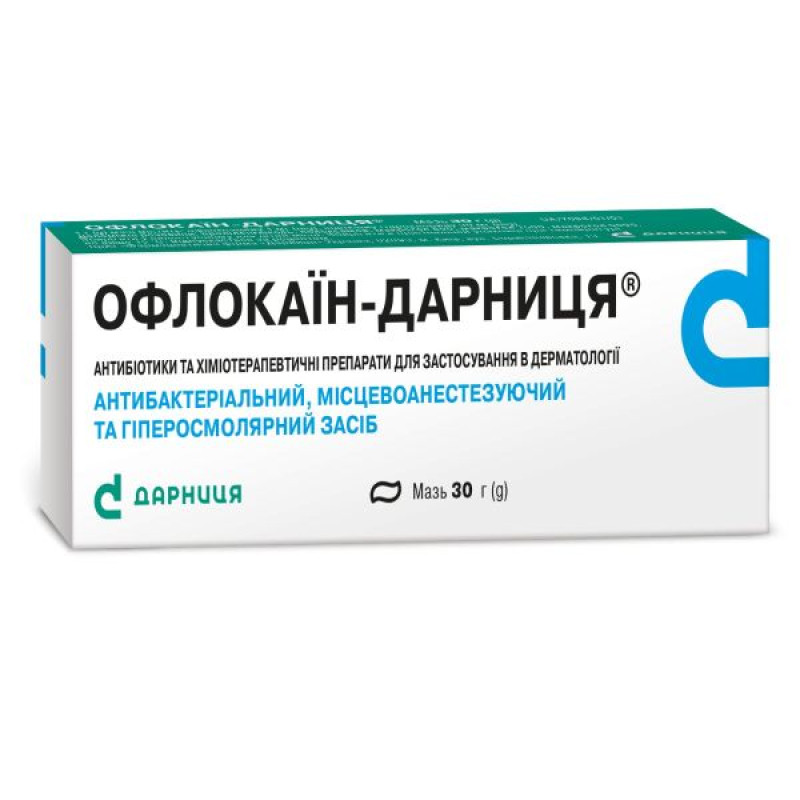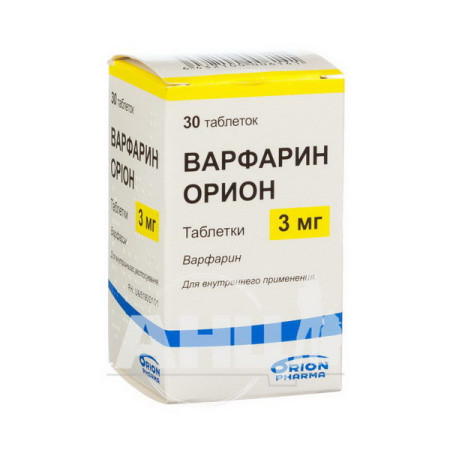Oflokain-Darnitsa ointment tube 30 g

Instructions for use of Oflokain-Darnitsa ointment tube 30 g
Composition
active ingredients: lidocaine hydrochloride, ofloxacin;
1 g of ointment contains: ofloxacin 1 mg, lidocaine hydrochloride 30 mg;
excipients: propylene glycol, poloxamer, macrogol 400, macrogol 1500, macrogol 6000.
Dosage form
Ointment.
Main physicochemical properties: homogeneous white ointment with a faint specific odor.
Pharmacotherapeutic group
Antibiotics and chemotherapeutic drugs for use in dermatology. Chemotherapeutic agents for topical use.
ATX code D06B X.
Pharmacological properties
Pharmacodynamics
Oflokain-Darnitsa® is a combination of the fluoroquinolone antimicrobial agent ofloxacin and the local anesthetic lidocaine on a hydrophilic, hyperosmolar, and water-soluble base. The pharmacological effects of the ointment are due to the properties of the active ingredients that make up its composition.
Ofloxacin acts on the bacterial enzyme DNA gyrase and bacterial tropoisomerase IV, exerting a bactericidal effect by destabilizing bacterial DNA chains.
Ofloxacin provides antimicrobial properties of the ointment due to its action on gram-positive and, to a greater extent, gram-negative bacteria, aerobic and anaerobic, spore-forming and asporogenic microflora in the form of monocultures and microbial associations. Ofloxacin is also effective against hospital strains resistant to antibiotics and sulfonamides.
The hyperosmolar, polymeric ointment base of the drug ensures the movement of water in the wound towards the ointment base. Due to this, swelling of the tissues around the wound is reduced, purulent-necrotic contents of the wound are absorbed. The excipients of the ointment base are able to conduct ofloxacin into the surrounding wound tissues, which ensures the effect on both superficial and deep wound infections.
The mechanism of local anesthetic action of lidocaine is to stabilize the neuronal membrane by reducing its permeability to sodium ions, which prevents the occurrence of an action potential and the conduction of impulses along nerve fibers. Antagonism with calcium ions is possible. It inhibits the conduction of not only pain impulses, but also impulses of other modalities. It is rapidly hydrolyzed in a slightly alkaline environment of tissues and after a short latent period acts for 60-90 minutes. The anesthetic effect of lidocaine is 2-6 times stronger than that of procaine. When applied topically, it dilates blood vessels, does not have a local irritating effect. In case of tissue inflammation (tissue acidosis), the anesthetic activity decreases. Effective for all types of local anesthesia. Dilates blood vessels. Does not irritate tissues.
Pharmacokinetics
Ofloxacin and lidocaine practically do not enter the systemic bloodstream when the ointment is applied to healthy skin. After application to the wound surface, when the barrier functions of the skin are impaired, about 3% of the applied dose of ofloxacin enters the systemic bloodstream. The peak concentration of substances in the blood is observed after 3-4 hours. After 6 hours after application of the ointment, ofloxacin is not detected in the blood.
Indication
Complicated infected wounds in the first phase of the wound process of various localization and origin: amputation stumps of limbs, wounds after surgical treatment of purulent foci. Pressure ulcers, trophic ulcers, postoperative complicated wounds and fistulas, abscesses and phlegmons of the maxillofacial region after their surgical treatment.
Prevention and treatment of suppuration of burn wounds.
Purulent-inflammatory skin diseases caused by bacterial microflora sensitive to ofloxacin.
Contraindication
Hypersensitivity to ofloxacin or other quinolone derivatives; hypersensitivity to lidocaine hydrochloride or other amide-type local anesthetics (e.g. bupivacaine, etidocaine, mepivacaine and prilocaine); hypersensitivity to other components of the drug.
Interaction with other medicinal products and other types of interactions
Absorption of lidocaine through the skin is usually low, but the drug should be used with caution in patients taking class I antiarrhythmic drugs (tocainide, mexiletine) or other local anesthetics, as there is a possible risk of cumulative systemic effects.
Monoamine oxidase inhibitors enhance the local anesthetic effect of lidocaine.
Application features
Before applying the drug to the wound surface, it is advisable to wash the wound with an aseptic solution.
Use during pregnancy or breastfeeding
Do not use the medicine during pregnancy or breastfeeding.
Ability to influence reaction speed when driving vehicles or other mechanisms
The drug does not affect the speed of neuromuscular conduction; in recommended doses, it can be used by people who drive vehicles and work with complex mechanisms.
Method of administration and doses
Oflokain-Darnitsa® should be applied topically.
Use tampons soaked in ointment to fill the cavities of purulent wounds after their surgical treatment, and insert gauze turundas with ointment into fistula passages.
When treating purulent wounds, apply the ointment once a day, when treating burns – daily or 2-3 times a week, depending on the intensity of purulent discharge.
The amount of ointment used is determined by the area of the wound surface (the ointment should cover the entire affected area) and the degree of purulent exudation.
The duration of treatment is determined by the doctor depending on the dynamics of cleansing the wound from purulent exudate and the timing of stopping the inflammatory process.
When treating dermatological diseases, apply a thin layer of ointment to the affected areas of the skin 1-2 times a day or on a gauze bandage with subsequent application.
Children
The medicine should not be used in children.
Overdose
No cases of overdose have been reported.
Adverse reactions
When using the ointment, the following reactions may occur: itching, burning sensation, rash, hyperemia, oozing, allergic reactions, including dermatitis, urticaria, Quincke's edema. Propylene glycol, which is part of the drug, can cause skin irritation.
Expiration date
2 years.
Storage conditions
Store in original packaging at a temperature not exceeding 15 °C.
Keep out of reach of children.
Incompatibility.
It is undesirable to simultaneously use other medications in the areas where Oflokain-Darnitsa® is applied.
Packaging
15 g or 30 g in a tube; 1 tube in a pack.
Vacation category
According to the recipe.
Producer
PrJSC "Pharmaceutical Company "Darnitsa".
Location of the manufacturer and its business address
Ukraine, 02093, Kyiv, Boryspilska St., 13.
There are no reviews for this product.
There are no reviews for this product, be the first to leave your review.
No questions about this product, be the first and ask your question.





